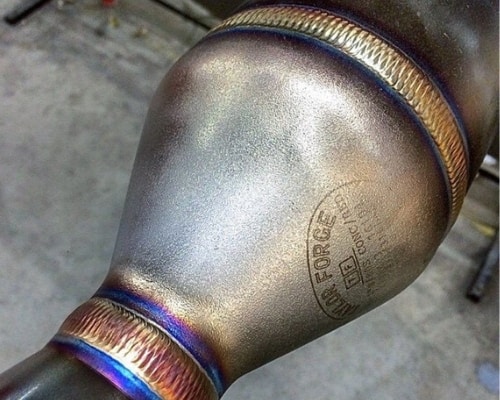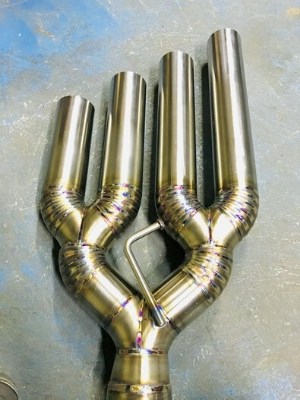What is TIG welding used for? Tungsten inert gas (TIG) welding, also commonly known as gas tungsten arc welding (GTAW), is a popular form of welding. If you’ve never used a TIG welding process before, you might wonder what advantage it has over MIG welding or even traditional stick welding.
Tons of people swear by TIG welding and use it as their primary welding method. Why invest in this process, and what is it used for?
What do you use TIG welding for? TIG welding allows for an extreme degree of precision and control with almost all metals. With TIG welding, the flow of electrons can be controlled mid-weld with a foot pedal or fingertip remote. This allows welds to be soft started and stopped. Although it takes some skill to perform correctly, TIG welding can produce some incredibly clean and polished final results.
TIG welding is an extremely versatile welding technology. Useful in a variety of fields, from aerospace to pharmaceutical. The strength of TIG welding really relies in the skill of the operator. Let’s take a look at what makes TIG welding so widely useful.
Table of Contents
Why Use TIG Welding? – Advantages
TIG welding is used to join two pieces of metal together by heating them with an arc between a non-consumable tungsten electrode and the work piece. The process is used in combination with an inert, non-reactive shielding gas which protects the electrode from contamination. Filler material may or may not be used, depending on the specific application.
The arc, once generated, heats the base metal to form a weld pool. Once the weld pool has been established, the welder moves the arc along the joint, melting the surfaces and allowing the weld pool to flow into the gap between the two pieces.
TIG welding has a number of benefits that make it one of the most desirable processes out there. Let’s take a look at them.
Almost All Metals Can be TIG Welded
Titanium, Nickel, Aluminum, Copper, Stainless Steel, and their alloys can all be welded using a TIG process. When using TIG, you don’t have to worry about having the right tool for the job. TIG can handle it no matter what material you’re using. You don’t even necessarily have to worry about having the matching filler material available because you TIG weld without filler material.
Superior Weld Quality
The biggest reason that people are drawn to TIG welding is because of the high quality, beautifully clean welds that come from using this process. Using a TIG welder properly results in a smooth, even weld. Even materials that can be difficult to weld smoothly, like stainless steel, can be impressively and beautifully joined using a TIG welder. This is because the real-time temperature control allows you to avoid overheating that will warp the metal.

This control allows you to avoid defects in the metal. The process doesn’t cause any spattered metal, which can result is a messy weld. Because you can sharpen your tungsten tip to get a really finely focused welding arc, you can also get a compact, thin weld seam. This allows your welds to be subtle and aesthetically pleasing.
The weld quality isn’t just aesthetic. The greater degree of control that allows for the welds to look pretty also allows the operator to ensure that the welds fully bond the two pieces. TIG welds are stronger and more resilient than welds using other processes.
Clean Process
While many other welding processes cause welding smoke, residue, and spatter—TIG is a clean process. No smoke is generated during welding. No residue is left behind. No spatter is produced by the torch. With a clean process like TIG, you don’t need to worry about dealing with smoke or fumes during the weld, and you don’t have to worry about cleaning up after the weld.
Stick welding especially leaves a layer of slag over the weld, which needs to be removed with a metal brush afterward. If you’re welding in bulk, having to constantly clean your welds can get quite tiresome. The cleanliness of TIG welding removes this chore entirely.
Good Penetration
When welding, penetration refers to how deep the weld extends beneath the surface of the material being welded. In many cases, the deeper the fusion line, the stronger the weld. Because of the highly focused welding arc, TIG welding allows for excellent penetration. This allows for strong, durable welds even when filler material is not used.

Materials You Can TIG Weld
TIG welding is suitable for welding a variety of metals, including carbon steels, low-alloy steels, alloyed stainless, nickel alloys, aluminum and its alloys, copper and its alloys, and other non-ferrous metals. In particular, TIG welding is often the best process for welding thinner metals such as steel and aluminum.
However, it’s important to note that different metals may require different welding techniques and considerations, as outlined in the search results. For instance, aluminum and magnesium require special consideration due to their quick heating and oxidation issues.
It’s always best to receive proper training and certification when learning to TIG weld, as welding involves both math and safety considerations, as mentioned in the previous conversation.
TIG welding Applications
TIG welding is a versatile welding process that can be used to weld a variety of metals. This process is suitable for carbon steels, low-alloy steels, alloyed stainless, nickel alloys, aluminum and its alloys, copper and its alloys, and more. TIG welders can even be used to weld gold.
However, welding different metals may require different techniques and considerations, and proper training and certification are still necessary.
TIG welding is often used in applications that require high-quality welds, such as aerospace, automotive, and medical industries. It is also commonly used for welding pipes, tubes, and other thin-walled materials.
How Strong Is TIG Welding?
TIG welding produces strong welds and is often used in high-quality applications such as aerospace, automotive, and medical industries, as well as for welding pipes, tubes, and other thin-walled materials.
TIG butt welds can reach up to 97% of the base metal’s ultimate tensile strength, which is about 664 MPa for AISI 304 stainless steel. However, it is important to note that different metals may require different welding techniques and considerations, and proper training and certification are necessary.
What Is Lift TIG Welding Used For?
Lift TIG welding is a process that uses a non-consumable tungsten electrode to produce a weld, protected by an inert shielding gas like argon or helium. This welding process is often used for high-quality applications and can weld a variety of metals, including gold.
Lift-Arc ignition, a feature of TIG welding, initiates the arc with a low start-up current that touches the tungsten electrode on the job and lifts it off, resulting in faster start-up, greater control, and reduced risk of contamination.
Proper training and certification are necessary for using TIG welding, and different metals may require different techniques and considerations.
What Is Pulse TIG Welding Used For?
Pulsed TIG welding is often used for welding stainless steel due to its excellent performance and efficiency, which can improve productivity and reduce weld costs.
This welding technique offers several advantages, including improved heat input control, penetration, travel speed, and weld quality, making it suitable for both in-position and out-of-position welding.
Pulse features also allow for the creation of a visually appealing, uniform, and reliable weld more easily, giving the appearance of a perfect weld. Pulse TIG welding can be used for both DC and AC welding, including welding aluminum, and recommended pulse settings include a frequency of 1.2Hz to 2.0Hz, a Duty % of 35, and a Background Amperage % of 35, with the amperage being double what you would normally use without pulse.
Disadvantages of TIG Welding
TIG welding is one of the best welding processes out there. It gets you gorgeous, high-quality welds with a lot of flexibility in how you work a wide array of metals. However, it doesn’t come without its disadvantages. The major reasons you might steer clear of TIG welding are the skill required to operate effectively and the cost relative to other welding technologies.
Skill
You get a great deal of flexibility with TIG welding. The ability to control the heat during the weld, the separate input of heat and filler material, sharpening or rounding the tungsten electrode—all of these add flexibility and allow you to use the welder in different ways. This flexibility also means that you really have to know what you’re doing. Having the knowledge to know when you want to apply those options in different combinations becomes critical to your success.
It’s not just the knowledge; there’s a mechanical aspect as well. To operate a TIG welder, you need to use two hands and a foot simultaneously. One hand holds your welding torch, the other applies filler material to the weld pool, while your foot controls the heat. Many other welding techniques only require the use of one hand and are therefore much easier to learn and build muscle memory for.
Cost
TIG welding isn’t cheap. The equipment for TIG welding costs many times as much as a MIG or stick welder. On top of that, TIG welding requires more energy, takes more time, can eat up more material, and requires a cleaner surface. All of this adds up to increase the cost of materials and labor going into each weld. TIG welding may be the best, but it doesn’t come cheap.
How to TIG Weld
If you decide that a TIG welder is right for your application, you’ll want to have some idea of what you’re doing. Obviously, there’s a lot to learn, and you’ll need some practice, but here are the basics of how to TIG weld:
| Steps | What to do? |
|---|---|
| 1 | Sharpen Your Tungsten Electrode |
| 2 | Insert the Electrode into the Collet |
| 3 | Select Your Settings |
| 4 | Turn on the Gas |
| 5 | Put on Your Safety Gear |
| 6 | Weld |
1. Sharpen Your Tungsten Electrode – You’ll want to keep your electrode sharpened to a fine point. As you weld, the point will wear down and become rounded. The sharper your point, the more focused your arc will be, and the less it will dance around on you. Before each weld, bring the tungsten rod to a belt grinder and bring it to a point.
2. Insert the Electrode into the Collet – You need to use the correct electrode for the alloy you’re welding with. Double-check that it’s correct, then insert the electrode until it’s about a quarter of an inch away from the protective sheath.
3. Select Your Settings – There are a number of different settings on the welder. Amperage, penetration, and other adjustments can be made. Make sure that everything is set correctly for your project.
4. Turn on the Gas – You need an inert gas to protect the metal from oxidizing while at high heat. Argon is commonly used, but you may need to adjust depending on your material for the best results.
5. Put on Your Safety Gear –Grab welding gloves, a welding coat, a welding helmet, and closed-toed shoes. You want every part of you protected.
6. Weld – Hold the electrode about an inch away from the metal. Allow the torch to form a welding pool then start slowly working from right to left (assuming you’re right-handed. If you’re left-handed reverse this.) Hold your filler material in your right hand and add it as necessary. Slow starting and slow stopping of the heat will give you a cleaner look.
More Welding Articles
Can MIG Welders Weld Aluminum? | How to successfully weld Aluminum?
Personal Protective Equipment for Welders – PPE | List, and Requirements
What is TIG Welding? >> Tutorial video

